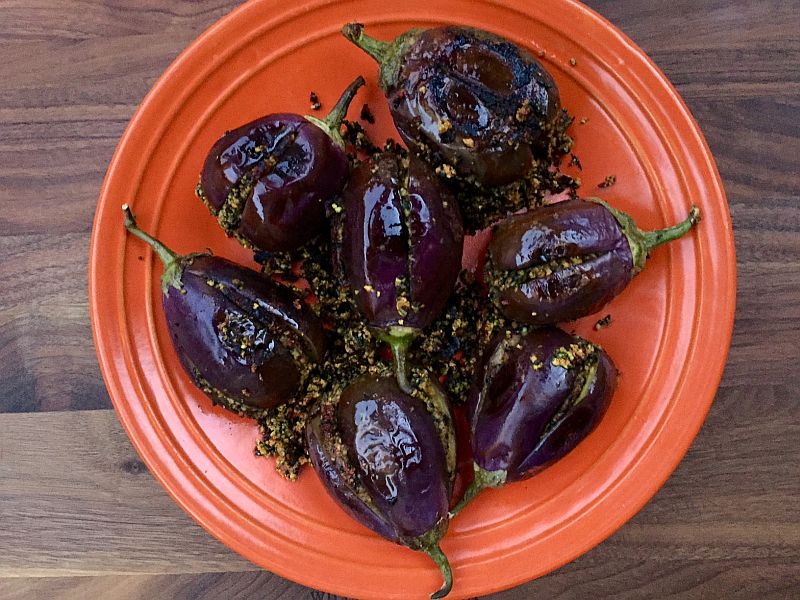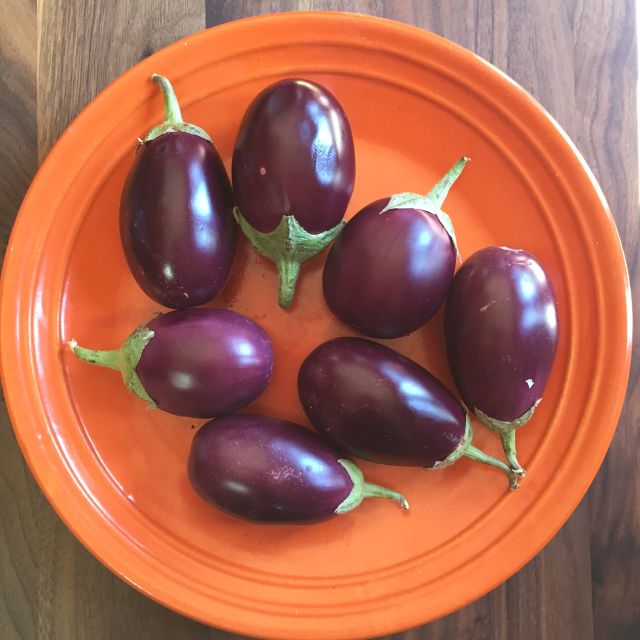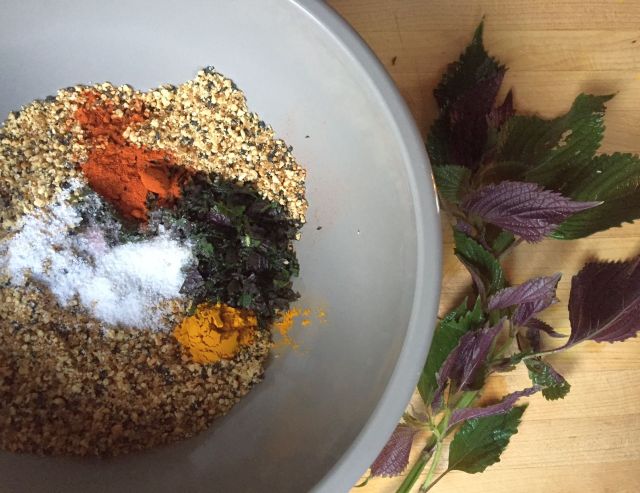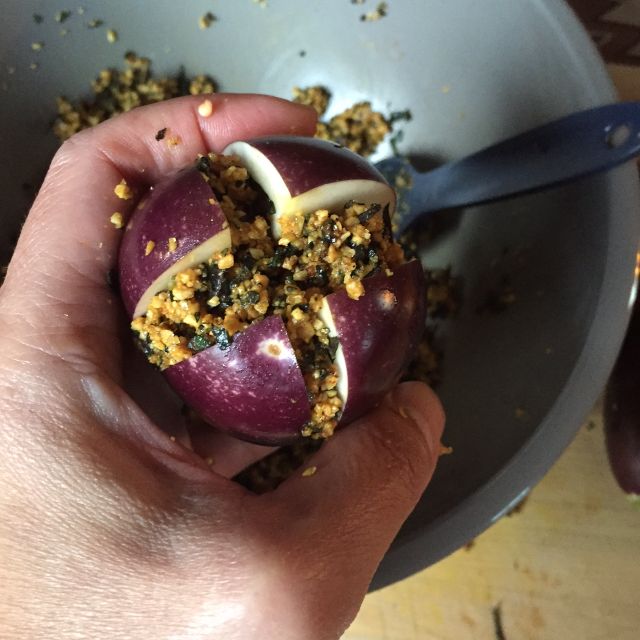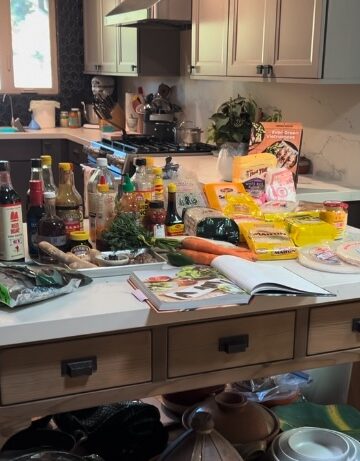Do you have recipes that you return to annually? I do, mostly because of an event or holiday (Tet! Thanksgiving!) or seasonality. This Indian dish is one I make when I can get excellent Indian eggplants from the Hmong farmers who come to our farmer’s market. The size of duck eggs, the eggplants are dense with thickish skins so they can hold the stuffing and not totally collapse into mushy nothingness after panfrying.
The recipe comes from one of my favorite Indian cookbooks, 5 spices, 50 dishes by Ruta Kahate. It’s a small book that shows you how to make good Indian food with only a handful of spices. Liberation. There are certain techniques that she teaches as well, which will take you far toward mastering Indian food. For example, heating up oil and letting spices aromatize in it is called tadka (aka bagar, chonkh, and phodni) and is a key part of the Indian kitchen.
I’ve been making this dish since I met Ruta in 2007, when her book came out. It’s easy and remarkably delicious. I’ve never seen it on Indian menus but it should be. No matter because you can make it at home. If you don’t have the eggplants (sold at Indian markets), substitute Japanese eggplants, she says.
For years I followed her recipe and used white sesame, peanut, and cilantro for the filling. With people telling me about peanut allergies, I decided to try cashew. I’d run out of regular hulled (white) sesame seeds and scrounged up some black ones in the freezer. I’d just purchased two bunches of tia to (red/garnet perilla) to make shiso drinking vinegar, and set several sprigs aside to substitute for the cilantro.
The mini food processor makes chopping things extra easy and fast. I’m annually skeptical that I can get all the stuffing inside the eggplant but I always do. Keeping a grip on the eggplant as you shove the stuffing inside works for me.
Then it was just a matter of panfrying the eggplants. I can’t remember what we ate with the eggplant because I just remember the eggplant tasting really good. Cashew is a little lighter than peanut but the black sesame and shiso lent great earthy flavor. Things looked a little darker than in years past but I took that for an artier look. There were leftovers, which reheated well for lunch in a skillet or microwave oven.
It's fun to revisit recipes and tweak them over time. It’s kinda like seeing an old friend with slightly new haircut.
Do you have an annual favorite dish to make? How long have you made it and how have you changed it over time?
RECIPE
Eggplant Stuffed with Sesame-Cashew Masala
Yield: Serves 4
Ingredients
- 2 tablespoons raw black sesame seeds
- ⅔ cup lightly salted, roasted cashews
- 2 tablespoons brown sugar
- 1 teaspoon fine sea salt, or 2 teaspoons kosher salt
- ½ teaspoon ground turmeric
- ½ teaspoon cayenne
- 1 teaspoon minced or crushed garlic
- ¼ cup finely chopped red shiso (tia to) or cilantro leaves
- ¼ cup plus 2 teaspoons water
- 8 Indian eggplants, or 6 small Italian or Japanese eggplants (1 ½ pounds total)
- 3 to 4 tablespoons canola or other neutral oil
Instructions
- For the filling, use a mini food processor to grind the sesame seeds, peanuts, sugar, salt, turmeric and cayenne to a crumbly texture. Transfer to a bowl and mix in the cilantro and 2 teaspoons water to create a compact, spreadable mixture. Set aside.
- Use scissors to trim the eggplant stems so that they are about ½ inch long. Use your fingers to remove the green pointy flaps of the eggplant caps. Make a deep cross incision in each eggplant, stopping ½-inch short of the stem. To do that, position each one on its side on your cutting board. Hold it down with one hand while you wield the knife with the other hand to make the first horizontal cut. Roll the eggplant 90 degrees and make the second horizontal cut.
- Use a teaspoon to stuff each eggplant with about ⅛ of the filling. Gently pry open the eggplant, stuff in the filling. Make sure there is filling between each of the cuts. Gently squeeze the eggplant to make the filling sticks and fills the crevices.
- Pour the oil into a large nonstick skillet over medium heat to film the bottom. When hot, add the eggplants in a single layer. Fry the eggplants for 3 to 4 minutes, turning frequently, to brown them on two sides. Don’t fret when some of the filling spills out. Add the remaining ¼ cup water, cover with a lid or foil, and turn the heat to low. Cook for 15 to 20 minutes, turning halfway through, until tender. Pierce with the tip of a knife to test. There will be filling in the skillet bottom. If you want to crisp those bits and serve them with the eggplant, increase the heat to medium high and fry for 1 to 2 minutes, until crisp. Remove from the heat, let the sizzling subside, then transfer to a plate and serve hot or warm.
Adapted from Ruta Kahate’s 5 Spices, 50 Dishes (Chronicle Books, 2007)













